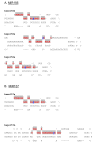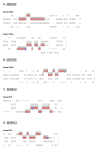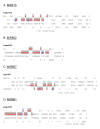Analysis of conserved microRNAs in floral tissues of sexual and apomictic Boechera species
- PMID: 21988906
- PMCID: PMC3208272
- DOI: 10.1186/1471-2164-12-500
Analysis of conserved microRNAs in floral tissues of sexual and apomictic Boechera species
Abstract
Background: Apomixis or asexual seed formation represents a potentially important agronomic trait whose introduction into crop plants could be an effective way to fix and perpetuate a desirable genotype through successive seed generations. However, the gene regulatory pathways underlying apomixis remain unknown. In particular, the potential function of microRNAs, which are known to play crucial roles in many aspects of plant growth and development, remains to be determined with regards to the switch from sexual to apomictic reproduction.
Results: Using bioinformatics and microarray validation procedures, 51 miRNA families conserved among angiosperms were identified in Boechera. Microarray assay confirmed 15 of the miRNA families that were identified by bioinformatics techniques. 30 cDNA sequences representing 26 miRNAs could fold back into stable pre-miRNAs. 19 of these pre-miRNAs had miRNAs with Boechera-specific nucleotide substitutions (NSs). Analysis of the Gibbs free energy (ΔG) of these pre-miRNA stem-loops with NSs showed that the Boechera-specific miRNA NSs significantly (p ≤ 0.05) enhance the stability of stem-loops. Furthermore, six transcription factors, the Squamosa promoter binding protein like SPL6, SPL11 and SPL15, Myb domain protein 120 (MYB120), RELATED TO AP2.7 DNA binding (RAP2.7, TOE1 RAP2.7) and TCP family transcription factor 10 (TCP10) were found to be expressed in sexual or apomictic ovules. However, only SPL11 showed differential expression with significant (p ≤ 0.05) up-regulation at the megaspore mother cell (MMC) stage of ovule development in apomictic genotypes.
Conclusions: This study constitutes the first extensive insight into the conservation and expression of microRNAs in Boechera sexual and apomictic species. The miR156/157 target squamosa promoter binding protein-like 11 (SPL11) was found differentially expressed with significant (p ≤ 0.05) up-regulation at the MMC stage of ovule development in apomictic genotypes. The results also demonstrate that nucleotide changes in mature miRNAs significantly (p ≤ 0.05) enhance the thermodynamic stability of pre-miRNA stem-loops.
Figures










Similar articles
-
The Boechera Genus as a Resource for Apomixis Research.Front Plant Sci. 2019 Apr 2;10:392. doi: 10.3389/fpls.2019.00392. eCollection 2019. Front Plant Sci. 2019. PMID: 31001306 Free PMC article. Review.
-
Novel microRNAs and microsatellite-like small RNAs in sexual and apomictic Boechera species.Microrna. 2013;2(1):45-62. Microrna. 2013. PMID: 25070713
-
A conserved apomixis-specific polymorphism is correlated with exclusive exonuclease expression in premeiotic ovules of apomictic boechera species.Plant Physiol. 2013 Dec;163(4):1660-72. doi: 10.1104/pp.113.222430. Epub 2013 Oct 25. Plant Physiol. 2013. PMID: 24163323 Free PMC article.
-
Apomictic and sexual ovules of Boechera display heterochronic global gene expression patterns.Plant Cell. 2010 Mar;22(3):655-71. doi: 10.1105/tpc.109.072223. Epub 2010 Mar 19. Plant Cell. 2010. PMID: 20305122 Free PMC article.
-
The miR156/SPL Module, a Regulatory Hub and Versatile Toolbox, Gears up Crops for Enhanced Agronomic Traits.Mol Plant. 2015 May;8(5):677-88. doi: 10.1016/j.molp.2015.01.008. Epub 2015 Jan 21. Mol Plant. 2015. PMID: 25617719 Review.
Cited by
-
A study of the heterochronic sense/antisense RNA representation in florets of sexual and apomictic Paspalum notatum.BMC Genomics. 2021 Mar 16;22(1):185. doi: 10.1186/s12864-021-07450-3. BMC Genomics. 2021. PMID: 33726667 Free PMC article.
-
Apomixis Technology: Separating the Wheat from the Chaff.Genes (Basel). 2020 Apr 10;11(4):411. doi: 10.3390/genes11040411. Genes (Basel). 2020. PMID: 32290084 Free PMC article.
-
The conserved chimeric transcript UPGRADE2 is associated with unreduced pollen formation and is exclusively found in apomictic Boechera species.Plant Physiol. 2013 Dec;163(4):1640-59. doi: 10.1104/pp.113.222448. Epub 2013 Oct 15. Plant Physiol. 2013. PMID: 24130193 Free PMC article.
-
The Boechera Genus as a Resource for Apomixis Research.Front Plant Sci. 2019 Apr 2;10:392. doi: 10.3389/fpls.2019.00392. eCollection 2019. Front Plant Sci. 2019. PMID: 31001306 Free PMC article. Review.
-
Genome-wide identification and characterization of miRNAs in the hypocotyl and cotyledon of cauliflower (Brassica oleracea L. var. botrytis) seedlings.Planta. 2014 Feb;239(2):341-56. doi: 10.1007/s00425-013-1986-x. Epub 2013 Oct 30. Planta. 2014. PMID: 24170336
References
-
- Simon JC, Delmotte F, Rispe C, Crease T. Phylogenetic relationships between parthenogens and their sexual relatives: the possible routes to parthenogenesis in animals. Biol J Linn Soc Lond. 2003;79:151–163. doi: 10.1046/j.1095-8312.2003.00175.x. - DOI
-
- Koch M, Bishop J, Mitchell-Olds T. Molecular systematics and evolution of Arabidopsis and Arabis. Plant Biology. 1999;1:529–537. doi: 10.1111/j.1438-8677.1999.tb00779.x. - DOI
-
- Böcher TW. Cytological and embryological studies in the amphi-apomictic Arabis holboellii complex. Det Kongelige Danske Videnskabernes Selskab. 1951;6:1–59.
Publication types
MeSH terms
Substances
LinkOut - more resources
Full Text Sources
Research Materials

